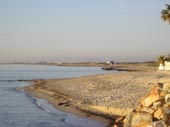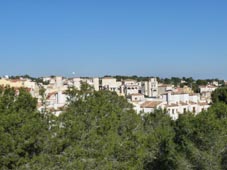Campoverde Spain – An attractive little village located inland of Pilar de la Horadada on the Costa Blanca, El Pinar de Campoverde (normally just referred to as “Campoverde”) has mostly developed due to the demand for holiday homes in the sun. Campoverde is especially renowned for its detached villas many of which stand on good sized plots and despite their inland position, still have sea views due to their being build on a hillside. This sizeable development of villas attracted the building of a new golf course for the area, and this has now taken shape in the form of the Lo Romero golf course, fast becoming one of the most popular courses in the area. Due to its inland position the villas of Campoverde were generally a little more affordable than similar properties built on the coast, this and its situation close to golf have added to its attractiveness. While inland, Campoverde is still within easy reach of the beaches of the Costa Blanca and Costa Calida, with also plenty of other golf courses nearby.
August 9, 2011
July 19, 2011
Torre de la Horadada Spain
Torre de la Horadada Spain: Perhaps one of the lesser known of the Costa Blanca’s seaside resorts, Torre de la Horadada is also one of the prettiest of the southern resorts, with attractive coastline and seafront walks, a charismatic watch tower dating from the time when pirates sailed these seas, numerous sandy beaches, sunny weather and a delightful marina with plenty of mooring space.
Despite the age of its tower, Torre de la Horadada has mostly developed during recent times, with the demand for coastal holiday homes growing and it really acts as the coastal arm of nearby Pilar de la Horadada, which as a town, falls a little short of the coast.
Very close to the border of Alicante and Murcia, Torre de la Horadada together with Pilar de la Horadada and El Mojon is one of the Costa Blanca’s southernmost resorts, head any further south and you will find yourself on the Costa Calida and the resorts of the Mar Menor, a little further and you will reach the city of Cartagena with its ancient Roman and Carthaginian ruins.
So if you are visiting the southern Costa Blanca region, don’t miss out on the charming little resort of Torre de la Horadada.
May 18, 2010
Pilar de la Horadada Costa Blanca
The attractive little town of Pilar de la Horadada is named after an ancient watchtower which was originally used to warn local inhabitants of pirate attacks many centuries ago. It was probably originally inhabited by the Iberians and was later settled by Romans, Moors and eventually reconquered by Christians. Pilar de la Horadada is the southernmost town in Alicante and the Costa Blanca, to the south is the Murcia region and the area known as the Costa Calida. After the Christian reconquest it marked the border between the Kingdoms of Aragon and Castile and it eventually ained its independence from the town of Orihuela in 1986. Pilar is well known as an agricultural area and grows much produce including lettuces, broccoli and celery, other products include melons, oranges and lemons, for this is citrus growing territory, it also grows numerous flower species. The nearby Rio Seco is an important protected area with some rare species of flora and fauna, in particular orchids and a species of dwarf palm tree. In recent years Pilar de la Horadada has become more developed with an increase in demand for holiday homes and properties for relocation, and the town now has a large expat community, with many Brits and North Europeans choosing to settle here permanently. Pilar has a popular beach area where many visitors enjoy the fine local weather especially during the hot summer months, it attracts both Spanish and International visitors.
November 18, 2009
El Mojon Costa Blanca

El Mojon Beach
A small coastal resort located near to Pilar de la Horadada on the southern Costa Blanca, El Mojon is right on the border between the regions of Valencia and Murcia in fact some of the homes come under the control of one region, whilst other come under the auspices of the other. Situated beside the Salinas y Arenales de San Pedro del Pinatar (Natural Park of the Salt Lagoons), its development threatens this protected area. El Mojon has excellent beaches and its small population of around 600, increases many fold during the summer months, when many visitors arrive to enjoy the climate, beaches and sea. Quite a bit of property development has taken place in the area and many have chosen to settle in El Mojon or buy holiday homes there.


